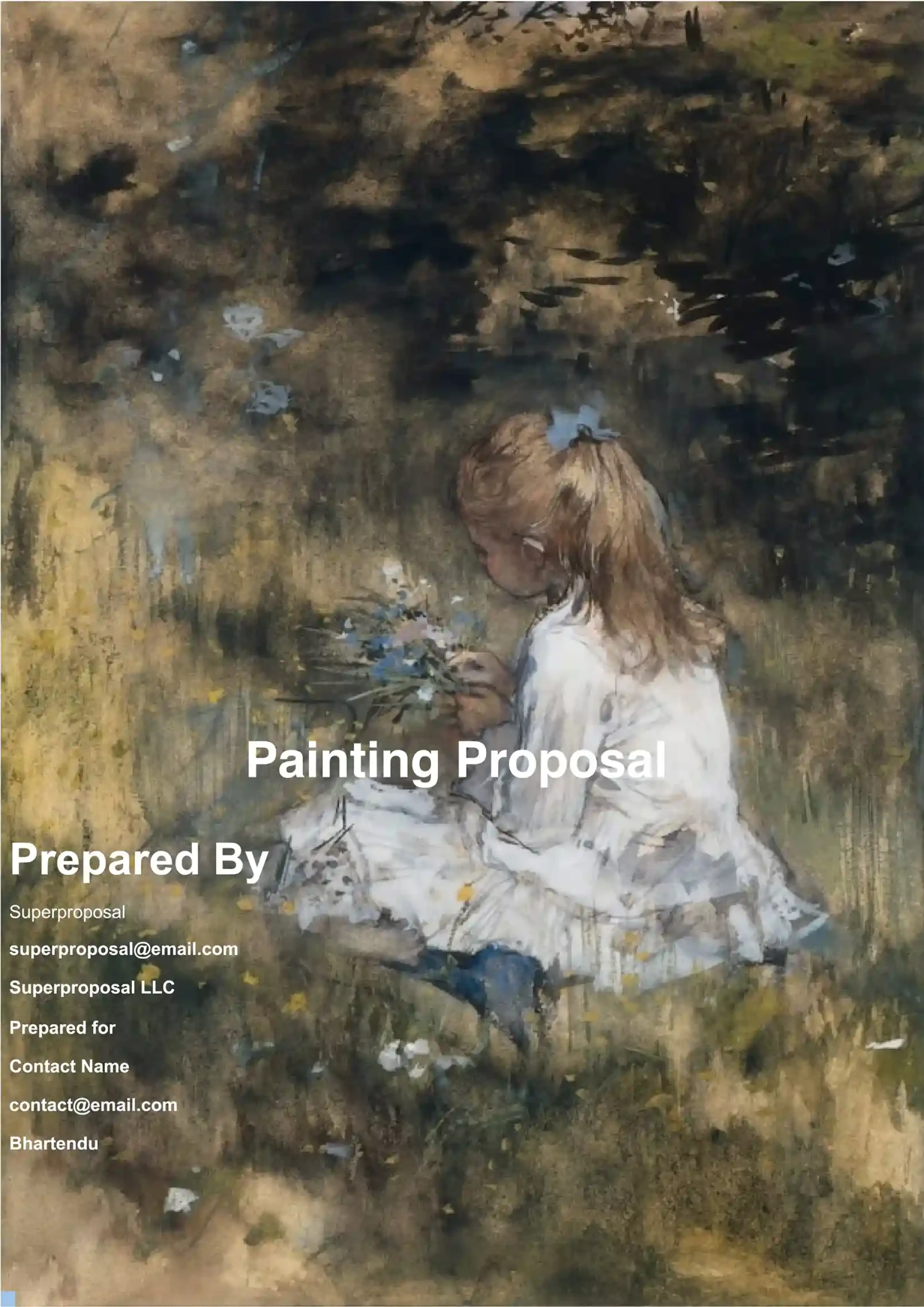In the competitive world of painting services, understanding and adjusting your painting proposal bid according to your client's budget is key to winning more projects and building lasting relationships. As a painting contractor or service provider, it's not just about offering the lowest price; it’s about presenting a bid that balances quality and affordability, ensuring you’re meeting your client’s needs while maintaining the integrity of your business.
We will also touch upon how the use of business proposal software, AV proposal software, and tools such as a free painting proposal template can assist in making this process much smoother and easier for you to make efficient changes in your proposals.
In this blog, we will learn how to adjust your painting proposal bid according to your client's budget. From identifying the right cost-saving measures to using business proposal software and a painting proposal template, we will guide you through the process to create a winning bid.
What is a Painting Proposal?
A painting proposal is a document provided to a potential client with all the scope of work, materials, and costs for a painting project. This provides all the essential information a client needs to make an informed decision regarding the hiring of a contractor.
The proposal generally consists of:
- Scope of work: Detailed description of the project that might involve surface preparation, painting techniques, and finishes.
- Materials: Type of paints, primers, and other materials.
- Timeline: Start date and end date.
- Cost estimate: Breakdown of labor, materials, and additional costs.
In other words, a painting proposal is like an outline for you and your client. It tells the client what to expect from you and what you expect from him. How to write a great proposal is very important in order to get the job.
Why is Adjusting Your Painting Proposal Bid Important?
Every client has a unique budget, and understanding how to adjust your painting proposal bid to fit within that budget can be the difference between winning and losing a project. Adjusting your bid doesn't necessarily mean lowering your prices—it's about offering value while aligning your services with the client's financial expectations.
By changing your bid to suit a client's budget, you:
- Increase your chances of getting the job: The proposals that meet the client's expectations are more likely to be accepted.
- Demonstrate flexibility: It often makes the client feel safe in your hands by accepting his financial constraints.
- Maintain profitability: You can offer competitive prices without losing the quality of work by adjusting your bid.
Key Strategies for Adjusting Your Painting Proposal Bid
Making adjustments to your bid is a combination of smart strategies. The following strategies will help you give an estimate that suits your client's budget and also protects your business's bottom line.
1. Know the Client's Budget
You can't make any adjustments without first knowing the client's financial expectations. Ask the right questions to get a clear picture of their budget:
- What is your target budget for the project?
- Are there specific cost constraints or areas where you would like to save money?
- Is there flexibility with the scope of work?
This information will help you understand where you might need to adjust your proposal, be it in reducing the scope of work or changing materials.
2. Provide Multiple Options
One of the effective ways you can adjust your bid is by presenting multiple options. For instance, if the client's budget is lower than what you initially estimated, propose an alternative proposal with different materials or a smaller scope. This way, the flexibility of choosing what works for them is given to the client while not compromising your chances of winning the job.
For example, you could propose:
- Option 1: Full-service proposal with premium materials and a detailed scope of work.
- Option 2: A more budget-friendly option with standard materials or fewer details.
This allows you to provide the client with the opportunity to make an informed decision that works within their budget.
3. Scope of Work Streamlining
Review the scope of work and look for opportunities to streamline. You may be able to reduce the overall cost by offering fewer layers of paint, smaller areas to cover, or a simpler application method. Here are some ways to reduce costs:
- Limit preparation work: If the surfaces are already in good condition, you might be able to reduce the time spent on preparation.
- Prioritize areas of high traffic: Take care of areas that, if painted, require attention the most. You would leave other, less conspicuous ones for the later stage of work.
- Simplify finishes: The finishes offered need not be an intricate or specialty type but instead a standard,
Adjusting the scope strategically can create a proposal with minimal cost without reducing the total quality of the project.
4. Utilize cost-effective materials
The costs for materials can be a substantial factor in the overall price. If the client's budget is tight, propose cost-effective materials without giving up on quality. Here is an example:
- Use lower-cost paint brands: Some of the best paint brands at higher prices have some very reasonable alternatives that are still top-notch.
- Use more effective materials: Some paints take fewer coats, which saves time and material.
- Use lower-cost finishes: Instead of luxury finishes, try the more common versions that will give similar strength and looks.
Using business proposal software will enable you to understand which materials are more expensive and hence ensure your bid is correct and well-arranged.
5. Adjust the Labor Costs
Labor is one other area that can be readjusted. If you want to lower the cost of a proposal, you can:
- Reduce the time: If you have better planning, you reduce the number of days it would take to finish the job. This is how you will be able to cut labor costs.
- Offer different crew sizes: If you are working with a large crew, it will be more expensive. You can offer a smaller crew for less complex jobs or tasks that do not require many workers.
Also, if you are using business proposal software or an AV proposal software, it will help you to easily calculate labor costs and adjust them according to the needs of the client.
Utilizing Business Proposal Software and Painting Proposal Templates
Use business proposal software and painting proposal templates; the tools can help efficiently alter your painting proposal bids, making the process a more streamlined creation of propositions and allowing for easy, quick change while remaining professional.
- Business proposal software: It will aid you in managing your proposals, tracking costs, and making quick adjustments. Automating calculations can help easily present updated bids based on client budgets.
- Painting proposal template: A pre crafted document that can facilitate structuring your proposals with ease. With a painting proposal template, free or paid, you ensure that your bid will look more presentable and won't lack the necessary elements for clarity and professionalism.
- Painting proposal example: You can get inspired by examples of previous successful proposals to make effective changes in future bids and discover new ways to present value to clients.
How to Create a Winning Bid Using a Painting Proposal Template
Using a painting proposal template also helps in creating consistency in all your projects and makes the adjustment of the bid according to the client budgets much easier. A proposed well-structured template that includes:
- Project Summary: This is a brief overview of the project.
- Scope of work Specific tasks, areas of painting, and other necessities for the project.
- Cost breakdown: clear and concise pricing of labor, material, and other services that will be included.
- Timeline: The time scheduled to complete the work
- Payment Terms: Conditions in relation to deposits, progress payments, and final payments.
If you are using a template for a painting proposal that is flexible and customizable, you are able to easily modify your cost, materials, and scope of work to meet your budget with the client.
Conclusion
Flexibility, strategic thinking, and professional tools are required to adjust your painting proposal bid according to your client's budget. It is possible to create a bid that fits within the client's budget while providing fair value for the price through an understanding of the client's financial needs and adjustments in scope, materials, and labor costs.
Leverage business proposal software, AV proposal software, or even a painting proposal template free to make it easier, and you'll be better able to get these fine-tuned adjustments done without sacrificing professionalism in presentation.
By following these strategies, you can be sure to present winning bids that appeal to your clients' needs and thus guarantee the long-term success of our painting business.
Read More: How to Submit a Winning Bid for Commercial Plumbing Jobs
Read More: How to Write a Follow-Up Email After Roofing Proposal Submission
Read More: How to Submit a Winning Bid for Property Management Jobs
Read More: How to Prepare for a Client Meeting After Submitting an Electrical Bid
Read More: Top 5 AV Proposal Software in 2025
Read More: How to Effectively Bid on Retail Business Jobs for Success: in 2025



